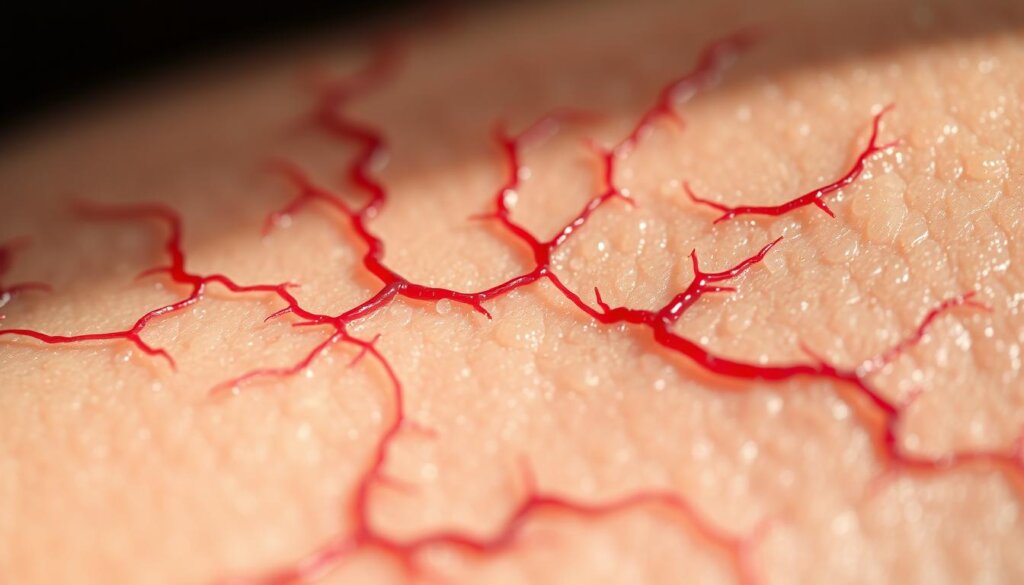Healing Timeline: How Long Is the Healing Process?
Did you know healing a simple skin cut usually lasts one to two weeks? During this time, the skin closes up, keeping infection out. But, the scar tissue takes much longer, sometimes over a year, to fully mature. This shows how the healing process length can vary, showcasing the body’s amazing ability to repair itself step by step.
The path from getting hurt to fully healed isn’t straightforward. The body goes through many stages, each one crucial for the tissue to fully heal. From the moment you’re injured, your body starts a series of steps. These range from an immediate response to final repair. This complex process, influenced by many factors like wound size and your health, highlights our incredible ability to heal.
When it comes to surgeries, healing has its own pace. Closed wounds often heal within 6 to 8 weeks. This quick healing is proof of the body’s concentrated effort to repair under the right conditions. It’s a powerful example of how our bodies are built to recover and protect themselves, ensuring our survival and well-being.
Key Takeaways
- Recovery spans a variable timeframe from days to over a year, depending on the extent of injury and individual health factors.
- The process of healing involves distinct stages from hemostasis to wound maturation and scar formation.
- Factors such as wound size, depth, and existing medical conditions significantly affect the recovery duration.
- Understanding the stages of healing can better inform treatment approaches and expected healing timelines.
- Surgical wounds typically follow a more predictable healing pattern, with complete recovery occurring within a matter of weeks under optimal care.
Understanding the Healing Process
Healing is a key process that aims to restore normal function to injured tissues. It involves several factors crucial for the outcome. Each one plays a significant role in how quickly and well the body heals.
Definition of Healing
Healing is the body’s way of fixing and regrowing itself. It’s not just about replacing harmed cells. It also keeps everything working right and balanced.
This process includes specific stages. They make sure everything heals properly and on time.
Phases of Healing
The healing journey has four key stages:
- Hemostasis: Right after an injury, this step helps stop bleeding through clotting.
- Inflammation: This part brings swelling and warmth, clearing out harmful debris to pave the way for healing.
- Proliferation: Healing slows a bit here as new tissue forms. It also brings back necessary blood flow for ongoing repair.
- Maturation: The final stretch, where tissues regain strength. Here, wounds fully heal as collagen reorganizes.
Factors Influencing Healing
Many things can impact how well and fast healing happens:
- Age: Younger people usually heal quicker. Aging tends to slow down the regeneration process.
- Underlying health conditions: Issues like diabetes or smoking can make healing harder by messing with blood flow and nutrient delivery.
- Nutritional status: Good nutrition is key. It supplies the essentials for building new tissue and supporting immunity during recovery.
Getting to know these stages and factors helps us understand how to better manage healing. This knowledge is invaluable in clinical settings.
Physical Healing: General Timeline
Recovery times vary widely, depending on the injury or condition’s nature and severity. It’s important to know typical healing times. This helps patients and doctors set realistic expectations. Here, we’ll look at how long it takes to recover from small injuries, big surgeries, and ongoing illnesses.
Minor injuries heal pretty quickly. Most small cuts, scrapes, and light muscle injuries get a lot better within three months. Keeping the injury clean, avoiding infection, and doing certain exercises can speed up healing.
Recovering from major surgeries takes longer. Surgeries have a big immediate impact, but advanced techniques help heal faster by reducing damage to nearby tissues. Recovery depends on the surgery type, the patient’s health, and after-surgery care. This can include special healing methods found through advanced therapeutic techniques.
Chronic conditions are a different story. They can slow down the body’s natural healing process. Issues like long-term injuries from diabetes or blood flow problems can double the usual healing time. Sometimes, they lead to wounds that don’t heal. Treating these may require addressing the overall health problem, which affects how long recovery takes.
In summary, recovery time can vary a lot. It’s influenced by the problem’s type and severity and how it’s treated. Knowing about these timelines helps manage expectations and improve treatment results.
Emotional Healing: An Overview
Emotional healing is essential for overall well-being, similar to how we treat physical injuries. These emotional wounds, hidden yet deep, need careful handling. Factors like personal experiences and one’s surroundings play a big role.
The time it takes to heal emotionally varies a lot. It depends on how trauma affected a person and the support they get. Knowing about grief stages and having the right recovery plans is very important. This helps create a space that supports true emotional healing.
-
Stages of Grief
Grieving involves a few key stages: denial, anger, bargaining, depression, and acceptance. Each one is an important part of healing. They help people face and eventually accept their loss or trauma.
-
Impact of Trauma
Trauma can make emotional recovery take longer. It does so by bringing up intense emotions and triggers. How deep the trauma is can set the speed and methods for healing.
-
Recovery Strategies
To aid healing, methods like therapy, joining support groups, and building personal strength are advised. Good emotional healing comes from steady and caring support, fitting each person’s needs.
So, even if it’s not something we can see, emotional healing is complex but very important. Understanding trauma’s effects, moving through grief, and using the right strategies can guide someone towards emotional recovery.
Mental Health Recovery
Mental health recovery includes both healing period and psychological aspects essential for wellness. Each person’s journey is unique, influenced by the condition’s severity, support networks, and mental strength. Time for recovery in therapy varies, depending on these factors.
Treatment plays a critical role in overcoming mental health challenges. Therapy timelines are customized to meet individual needs. Success depends on ongoing support from family, friends, and therapists.
- Timeframe for Therapy: Everyone’s recovery path differs. Some might improve quickly, within months, while others take longer.
- Importance of Support Networks: Strong support networks are vital for emotional support during recovery. They offer encouragement and help reduce stress for better outcomes.
Knowing these aspects helps those caring for people with mental health issues. It highlights the importance of patience and tailored care approaches.
Healing from Surgical Procedures
Recovery time after surgery can differ a lot. It depends on how complex the surgery was and the person’s health. Knowing these differences and taking good care after surgery are key. They help make recovery quicker and ensure the body heals well.
Once surgery is done, the body works hard to heal the wound. This healing is vital for getting back to normal and avoiding problems. Wounds usually heal in about 6 to 8 weeks if everything goes well.
To help recovery go smoothly, careful post-surgery care is a must. Listening to doctors’ advice is crucial for a good recovery. They tell patients how to take care of the wound and how much they should move. Here are some top tips for better recovery:
- Maintain wound cleanliness and moisture to avoid infection and heal faster.
- Get plenty of rest, but also move as advised to help repair tissues.
- Watch out for complications and talk to a doctor if needed.
| Type of Surgery | Expected Recovery Duration | Key Post-Operative Actions |
|---|---|---|
| Minor outpatient surgeries | 2-4 weeks | Minimal activity, regular wound checks |
| Major invasive surgeries | 6-12 weeks | Follow physical therapy closely, go for check-ups regularly |
| Cosmetic surgeries | 4-8 weeks | Do gentle activities as recommended, keep a close eye on surgical sites |
Understanding the expected recovery time, keeping an eye on the healing, and consistent care after surgery can greatly improve recovery.
The Role of Nutrition in Healing
Nutrition is very important in how fast we heal. Eating right can help your body fix itself much faster. It’s important to know which foods help with healing. This will make getting better quicker.
Key Nutrients for Recovery
Certain nutrients are key for speedy recovery. These important ones are:
- Zinc: Essential for wound healing; enhances immune function.
- Iron: Vital for oxygen transport in the blood, supporting energy levels during recovery.
- Copper: Plays a role in forming red blood cells and maintaining immune health.
- Magnesium: Aids in muscle and nerve function, also regulates heart rhythm.
Dietary Recommendations
Following the right dietary advice can shorten healing time. For those getting over surgery or sickness, eating foods that fix tissue and boost immunity is key. Here are some foods rich in the nutrients we talked about:
| Nutrient | Food Source | Benefits |
|---|---|---|
| Zinc | Oysters, beef, pumpkin seeds | Enhances the immune system and wound healing processes |
| Iron | Red meat, spinach, lentils | Improves energy levels and aids in recovery |
| Copper | Shellfish, whole grains, nuts | Supports red blood cell formation and immune health |
| Magnesium | Almonds, black beans, tofu | Regulates muscle and nerve functions |
Eating right not just speeds up healing but also boosts overall health and wellness. Adding these nutrients to your diet is key to a good recovery.
Alternative Healing Methods
Exploring alternative healing methods opens up exciting paths to improve healing speed and recovery time. With acupuncture and herbal remedies, these practices enhance traditional medical care. They draw on the body’s own ability to heal.
Acupuncture comes from traditional Chinese medicine. It uses thin needles placed at precise body points. This method reduces pain and helps relax, which speeds up healing.
Herbal remedies have been around for ages, tackling many health issues. They help the body recover faster and boost the immune system. The power of herbs is key in maintaining health and wellness.
| Method | Benefits | Typical Usage |
|---|---|---|
| Acupuncture | Reduces pain, enhances relaxation | Treatment sessions vary, typically 30-60 minutes |
| Herbal Remedies | Boosts immunity, accelerates healing | Daily intake as advised by a herbalist |
These alternative healing methods not only help cut down recovery time but also boost overall health. Adding them to your healthcare can complement regular medical treatments well.
Healing After Illness
Recovering from illnesses like the common cold and flu needs us to understand their healing timelines. How long it takes to get better can depend on your health and the care you get.
Common colds usually get better faster, in a few days to two weeks. The flu might take longer to shake off because it hits harder. Taking care of symptoms well is key to heal fast and feel less discomfort.
| Illness | Typical Healing Period | Recommended Care |
|---|---|---|
| Common Cold | 1-2 weeks | Hydration, Rest, Over-the-counter meds |
| Flu | 2-3 weeks | Antiviral medication, Increased fluid intake, Rest |
Knowing how long healing takes helps manage expectations and plan care. It lets people and caregivers make a care plan that makes getting better easier and more comfortable.
Understanding Scar Tissue Formation
Scar tissue is a key part of healing. It moves us from injury to recovery. It keeps the structure of tissue strong after an injury.
When our bodies heal, scar tissue starts forming. This happens during a healing stage called the proliferation stage. Here, collagen builds up. It’s a protein we need to heal wounds. The collagen fibers fill in or replace damaged tissue, creating a scar.
When Does Scar Tissue Form?
Scar tissue starts forming right after a wound begins to close. This usually happens in the healing phase after the first inflammation. At this vital time, our bodies make new collagen fibers. These fibers strengthen the wound area and begin the scar tissue process.
How It Affects Healing
Scar tissue plays a big role in healing. At first, it protects the wound and makes the area stronger. But, scar tissue is stiff. It can make the skin or tissue less flexible and movable. This is especially true for large scars.
Doctors need to understand scar tissue. It helps them help patients heal well. They work to make sure healing goes smoothly. At the same time, they try to keep movement problems low.
The Impact of Age on Healing
The relationship between age and healing is key in medical science. It shows us how healing times vary for different ages. This insight helps tailor treatment and care strategies for everyone.
Children vs. Adults: Kids heal faster, thanks to their speedy metabolism. This means their cells rebuild quickly, shortening their healing time. Adults, however, heal more slowly. This slowdown is often due to lifestyle choices and ongoing health issues.
Elderly Considerations: Healing is toughest for the elderly. They deal with slower bodily functions, less blood flow, and long-term illnesses. These factors make recovery slower compared to younger people.
| Age Group | Metabolic Rate | Average Healing Process Length |
|---|---|---|
| Children | High | Short |
| Adults | Moderate | Medium |
| Elderly | Low | Long |
Emotional Support During Healing
Having emotional support while healing is very important. It helps speed up recovery. Emotional support is a big piece of getting better.
It’s important to get help from therapists or counselors when dealing with tough emotions. They offer the right support and teach how to handle stress and sadness.
Support from others is also key. This includes group therapy and being active in the community. These groups help by sharing stories and support.
Here are some ways to get emotional support during healing:
- Professional Counseling: Tailored strategies to confront personal and psychological challenges.
- Support Groups: Sharing experiences that validate individual feelings and promote communal healing.
- Educational Workshops: Learning about emotional health and effective recovery strategies to aid healing processes.
| Support Type | Benefits | Typical Activities |
|---|---|---|
| Professional Counseling | Offers a safe space for emotional expression and helps develop coping mechanisms. | Therapy sessions, Cognitive Behavioral Therapy (CBT), Emotional Focused Therapy (EFT) |
| Support Groups | Enhances feelings of connectivity and shared journey through recovery. | Group meetings, Online forums, Community-led events |
| Educational Workshops | Provides tools and knowledge to understand and manage emotions effectively. | Workshops on emotional wellness, Stress management classes |
Coping Mechanisms for Pain During Healing
During healing, people look for ways to deal with pain. They want to make their recovery smoother without just using meds. Using mindfulness and meditation with physical therapy helps. This way, they handle discomfort better and heal well.
Mindfulness and meditation help a lot when you’re healing. They keep your mind sharp and lower stress. This balance is key to getting better faster. Making meditation a regular thing can really change how you handle pain.
At the same time, physical therapy is vital. It gets you back to your normal self by making muscles stronger and more flexible. Custom therapy plans match your health needs and goals. This makes healing not just easier but also improves over time.
| Technique | Purpose | Benefits |
|---|---|---|
| Mindfulness and Meditation | Stress Reduction | Improves mental health, enhances focus, reduces feelings of pain |
| Physical Therapy | Pain Management and Mobility Improvement | Increases strength, improves mobility, reduces recovery duration |
Using mindfulness and physical therapy together helps a lot. It does more than just ease pain right now. It helps heal better in the long run. Each session makes you better at managing pain during recovery.
The Importance of Patience in Healing
Being patient while healing is essential for mental health and growing stronger. Knowing the healing steps helps people set smart goals for getting better. Patience not only helps with mental health but also gives the strength needed to face health problems.
The mental side of healing is very important. Understanding that healing goes up and down helps with dealing with the stress of delays. Knowing this helps keep a positive attitude even when things get tough.
Patience is also crucial in getting stronger after a health issue. It helps people get through tough times and see problems as just small parts of getting better. By accepting every step of healing with hope, the path to recovery feels easier.
Knowing how healing works mentally and working on becoming stronger greatly improves recovery. People who are patient during recovery cope better and manage the emotional challenges well.
When to Seek Medical Advice
Knowing when to get medical advice is key for handling health issues well. Spotting signs of trouble early can greatly help speed up and improve the healing process. This part talks about the main signs you need to see a doctor and how following your doctor’s advice is crucial for healing.
Signs of Complications
Healing complications can be different, but some common symptoms mean you should get help right away. These symptoms are constant or worse pain, too much swelling, redness near the problem area, feeling hot, and pus coming out. These might mean you have an infection or another big problem.
Knowing When It’s Time
Getting help fast is critical to stop complications from getting worse. If you notice any symptoms mentioned before, see your healthcare provider fast. Finding and treating problems early can keep your health from getting worse and make healing smoother.
| Symptom | Possible Complication | Recommended Action |
|---|---|---|
| Persistent Pain | Infection, improper healing | Seek immediate medical advice |
| Redness and Warmth | Signs of infection | Contact healthcare provider |
| Swelling | Inflammation or fluid build-up | Consult with a medical professional |
| Discharge of Pus | Possible severe infection | Get medical advice for healing |
Healing Beyond the Body
Healing is more than just fixing the body. It includes spiritual and holistic ideas that help our emotional and mental health. Realizing the value of these ideas can make the healing time better. It brings a balance that connects the mind, body, and spirit.
Spiritual approaches to healing and holistic healing methods are getting more attention for their positive effects. Yoga, meditation, and energy healing help with both physical and mental health. These practices are key in dealing with emotions and thoughts during healing. They offer a break from daily stress, leading to peace and clarity needed for recovery.
These spiritual and holistic ways work by connecting deeply with our inner self. This connection leads to harmony within, which is key for healing.
Using these methods in our healing can speed up recovery and lead to better overall health. It shows how important it is to care for our emotional and spiritual sides, not just our physical body.
Conclusion: Your Personalized Healing Journey
Healing is a unique journey for everyone. It’s made up of personal details: our health and life experiences. How long it takes to heal isn’t the same for everyone. It changes based on our bodies, the kind of injury or illness, and our own strength.
Healing isn’t just about getting better physically. It also involves our minds and emotions. The time to recover isn’t only about medical care. It also depends on living a healthy lifestyle, eating well, and using other helpful treatments. Combining these helps us move forward in our own healing path.
We want to help you understand how healing works, especially in regenerative medicine. Knowing more lets you make smart choices in your recovery. When you follow a plan that’s right for you and listen to medical advice, getting better is not just a hope. It becomes something you can truly achieve.








